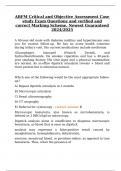ABFM Critical and Objective Assessment Case
study Exam Questions and verified and
correct Marking Scheme, Newest Guaranteed
2024/2025
A 60-year-old male with diabetes mellitus and hypertension sees
you for routine follow-up. He has no acute health concerns
during today's visit. His current medications include metformin
(Glucophage), lisinopril (Prinivil, Zestril), and
hydrochlorothiazide. He smokes cigarettes and has a 40-pack-
year smoking history. His vital signs and a physical examination
are normal. An in-office dipstick urinalysis reveals + blood and
trace protein but is otherwise normal.
Which one of the following would be the most appropriate follow-
up?
A) Repeat dipstick urinalysis in 3 months
B) Microscopic urinalysis
C) Renal ultrasonography
D) CT urography
E) Referral for cystoscopy - correct answer B
Microscopic hematuria, also known as microhematuria, is
defined as 3 RBCs/hpf on microscopy.
Dipstick analysis alone is insufficient to diagnose microscopic
hematuria, as blood that is seen on dipstick
analysis may represent a false-positive result caused by
myoglobinuria, hemoglobinuria, dehydration,
exercise, menstrual blood, or povidone-iodine, as opposed to true
hematuria. Thus, when the presence of
,blood is suggested by dipstick urinalysis, confirmation with
microscopic analysis should be obtained. The
current guideline from the American Urological Association
(AUA) stratifies further workup for
microscopic hematuria based on the patient's overall risk of
genitourinary malignancy, rather than
automatic referral for cystoscopy and CT urography for all adults
35 years old with microhematuria, as
was recommended in the previous AUA guideline. According to
the current guideline, further evaluation
may include renal ultrasonography, CT urography, and/or
cystoscopy, depending on the patient's level
of risk. Patients who are at low risk also may be given the option
to repeat a urinalysis in 6 months. For
this patient the next step would be microscopic urinalysis to
determine the presence of hematuria, and, if present, to quantify
it. If microscopic urinalysis confirms the presence of hematuria,
then CT urography
and cystoscopy would be indicated, as his age, male sex, and
smoking history place him at increased risk
of malignancy. Repeating the dipstick analysis in 3 months would
be inappropriate in this situation, as the
presence or absence of true microscopic hematuria needs to be
clarified because of his high-risk history.
2. A 33-year-old gravida 2 para presents to the hospital at 35
weeks estimated gestation with premature rupture of
membranes. A decision is made to manage the pregnancy
expectantly and
,delay delivery unless signs of infection or fetal distress are
noted.
Based on current evidence, expectant management rather than
immediate delivery increases the
risk of which one of the following complications?
A) Cesarean delivery
B) Antepartum or postpartum maternal hemorrhage
C) Time spent in the neonatal intensive-care unit
D) Neonatal sepsis
E) Perinatal or infant mortality - correct answer B
While historically the optimal management of premature rupture
of membranes between 34 and 36 weeks has been unclear, based
on the PPROMT (Preterm Pre-labour Rupture of the Membranes
close to Term) trial published in 205, expectant management
appears to be associated with better neonatal outcomes.
Expectant management decreases the risk of cesarean delivery,
neonatal respiratory distress, mechanical ventilation, time spent
in the neonatal intensive-care unit, and time spent in the
hospital. Expectant management did increase the risk of
maternal antepartum or postpartum hemorrhage and
intrapartum fever.
No differences were found between immediate delivery and
expectant management in the risk of neonatal
sepsis, pneumonia, or perinatal or infant mortality.
3. Which one of the following represents a CONTRAINDICATION
to statin use?
A) Current pregnancy
B) Chronic hepatitis C infection
, C) End-stage renal disease
D) Myositis associated with a creatine kinase level five times the
upper limit of normal
E) Transaminitis due to nonalcoholic steatohepatitis - correct
answer A
Statins have been associated with fetal anomalies and are
contraindicated during pregnancy and not
recommended during breastfeeding. With appropriate
monitoring, statins may be used in patients with
chronic hepatitis C infection, end-stage renal disease, and
transaminitis due to nonalcoholic fatty liver
disease (including nonalcoholic steatohepatitis). Statins also may
be continued in the setting of myositis
with a creatine kinase up to 0 times the upper limit of normal,
provided that the muscle-related symptoms
are tolerable to the patient.
4. A 2-year-old female is brought to the urgent care clinic
because of a fever. On examination she has a temperature of
39.7°C (03.5°F). Within a short period of time while at the clinic
she develops a barking cough and respiratory distress, and you
note rapid deterioration of her condition.
Which one of the following is the most likely diagnosis?
A) Bacterial tracheitis
B) Epiglottitis
C) Foreign body aspiration
D) Peritonsillar abscess - correct answer A




